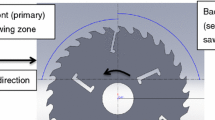Abstract
A new manufacturing system, the PrimWood Method, has been proposed to improve the utilization of wood. A basic concept within this method is the sawing pattern called star-sawing, which produces timber with both rectangular and triangular cross sections. This method facilitates an efficient production of radially sawn timber with vertical annual rings, without juvenile wood. The sawn timber produced in the PrimWood Method is used to produce high quality, knot-free solid wood panels with vertical annual rings. In this process, part of the timber is finger-jointed to form knot-free lengths which are glued together into a block. This block can then be divided according to thickness into thinner panels with vertical annual rings. The PrimWood Method has been tested in an industrial plant. The manufacturing system was designed for a sawing capacity of about 30,000 m3 logs, which corresponds to 16,800 m3 of star-sawn timber per shift per annum. The production of solid wood panel was then designed to give a volume of 5,800 m3 per annum.
Zusammenfassung
In der vorliegenden Arbeit wird ein neues Verarbeitungsverfahren, die sogenannte Primwood Methode, zur Verbesserung der Holznutzung vorgestellt. Ein grundlegendes Konzept dieses Verfahrens ist das Einschnittmuster, genannt „Sternsägen“, welches Nutzholz mit rechteckigen und dreieckigen Querschnitten liefert. Diese Methode erleichtert eine wirtschaftlich effiziente Herstellung von radial geschnittenem Nutzholz mit stehenden Jahresringen ohne Juvenilholz. Das auf diese Weise hergestellte Schnittholz wird verwendet, um astfreie, qualitativ hochwertige Vollholzplatten mit stehenden Jahresringen zu produzieren. Darüberhinaus werden diese Platten mit Keilzinkung versehen, um astfreie Abschnitte zu bilden, welche zu einem Block verleimt werden. Dieser kann dann der gewünschten Dicke entsprechend in dünnere Platten mit stehenden Jahresringen aufgeteilt werden. Die Primwoodmethode wurde im industriellen Maßstab geprüft. Der Betrieb war für eine Kapazität von ungefähr 30.000 m3 Roh- Rundholz ausgelegt, was ungefähr 16.800 m3 sterngesägtem Schnittholz pro Schicht und Jahr entspricht. Anschließend wurde die Produktion von Vollholzplatten auf ein Volumen von 5.800 m3 pro Jahr eingerichtet







Similar content being viewed by others
References
Holmberg H (2000) Influence of grain angle on Brinell hardness of Scots pine (Pinus sylvestris L). Holz Roh- Werkstoff 58:91–95
Sandberg D (1996a) Radially sawn timber. Star-sawing—a new method for producing timber with vertical annual rings. Holz Roh- Werkstoff 54(3):145–151
Sandberg D (1996b) The influence of pith and juvenile wood on proportion of cracks in sawn timber when kiln dried and exposed to wetting cycles. Holz Roh- Werkstoff 54(3):152
Sandberg D (1997a) Utvärdering av sönderdelningsmetod för stjärnsågning. (Evaluation of a conversion method for star-sawing.), KTH, Wood Technology and Processing, Report TRITA-TRÄ R-97-26 (in Swedish with an English abstract)
Sandberg D (1997b) Radially sawn timber. The influence of annual ring orientation on crack formation and deformation in water soaked pine (Pinus silvestris L) and spruce (Picea abies Karst) timber. Holz Roh- Werkstoff 55(3):175–182
Sandberg D (1997c) The influence of annual ring orientation on strength and dimensional changes during moisture variation in finger joints. Holz Roh- Werkstoff 55(1):50
Sandberg D (1998) Value activation with vertical annual rings—material, production, products. Dissertation, KTH-Royal Institute of Technology, Dept. of Manufacturing Systems, Wood Technology and Processing, Report TRITA-TRÄ R-98–36
Sandberg D (1999) Weathering of radial and tangential wood surfaces of pine and spruce. Holzforschung 53(4):355–364
Sandberg D (2005) Distortion and visible crack formation in green and seasoned timber—Influence of annual ring orientation in the cross section. Holz Roh- Werkstoff (in press)
Sandberg D, Holmberg H (1996) Radially sawn timber. Knots number, type and size in star-sawn triangular profiles of pine (Pinus silvestris L) and spruce (Picea abies Karst). Holz Roh- Werkstoff 54(5):369–376
Sandberg D, Stehr M (1997a) Bending strength of I-beams with webs of wood-fibre board and flanges of star-sawn triangular profiles. Holz Roh- Werkstoff 55:292
Sandberg D, Wålinder M, Wiklund M (1997b) The concept of value activation—a better utilization of wood. KTH-Royal Institute of Technology, Dept. of Manufacturing Systems, Wood Technology and Processing, Report TRITA-TRÄ R-97-27
Sandberg D, Holmberg H (1998) Radially sawn timber. Gluing of star-sawn triangular profiles into form-stable products with vertical annual rings. Holz Roh- Werkstoff 56(3):171–177
Author information
Authors and Affiliations
Corresponding author
Rights and permissions
About this article
Cite this article
Sandberg, D. Radially sawn timber—the Primwood Method for improved properties. Holz Roh Werkst 63, 94–101 (2005). https://doi.org/10.1007/s00107-004-0531-9
Published:
Issue Date:
DOI: https://doi.org/10.1007/s00107-004-0531-9



